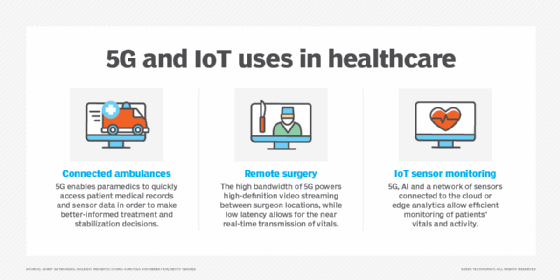5G in healthcare: 9 benefits and use cases
5G cellular's low latency and broad scalability have huge implications for healthcare, from real-time patient monitoring, to remote diagnosis and surgery, to fast medical imaging.
5G cellular networks are poised to revolutionize healthcare operations at urban and rural facilities alike, enabling clinicians to access hospital systems anywhere, with fast and reliable coverage across clinical settings inside hospitals and at remote locations.
In the aftermath of the COVID-19 pandemic, which accelerated remote patient care and made clinicians and patients more dependent on technology outside of hospitals, 5G promises to vastly improve delivery of myriad healthcare services. Everything from remote robotic surgeries and immersive technology for virtual medical training to telehealth consultations will benefit, not to mention AI-powered workflows and large-scale remote patient monitoring using countless IoT devices.
5G can address the deficiencies of the software and devices used in healthcare as well as improve their quality, reliability and security, according to Robin Goldsmith, practice leader for health and life sciences at Verizon Business, a major provider of 5G cellular. It can also help with the industry's chronic personnel shortages, he said.
"All the players in healthcare are looking at technology not to replace folks, but to fill the gaps where we don't have enough doctors and nurses," Goldsmith said. "Let's be honest: Wi-Fi networks were not built to handle these types of use cases."
While the technology offers promise, the use of 5G in healthcare is still nascent, said Octavio Garcia, a senior analyst at Forrester Research who covers telecommunications technology. "We find that anything to do with wearables, such as cardiac monitors, diabetes monitors and blood pressure devices, have shown advancements. Use cases that use 5G for remote robotic surgeries and teaching sessions using immersive technology are just emerging and haven't generally been embraced by healthcare stakeholders, at least not yet," Garcia said.

At its most basic level, 5G is important to healthcare operations because it can transfer large volumes of patient documents, videos and imaging files at much faster speeds than 4G or Wi-Fi networks. This is possible because 5G comes with extremely low latency, which is a delay in the time it takes a signal to travel between devices on a network.
In an industry where patients' health information is a valuable source of insights that drive clinical decisions, the stakes of adopting 5G networks are high.
"5G brings scalable, secure connectivity across tens of thousands of devices, enabling care teams to access systems and collaborate seamlessly inside and outside clinical spaces," said Chris Melus, vice president of product management at T-Mobile, another big 5G provider. "Compared to Wi‑Fi, it delivers smoother handoffs, wider reach and the reliability healthcare demands. That reliability lays the groundwork for smarter, more connected care delivery."
One institution that has adopted 5G is Boston Children's Hospital. T-Mobile launched the first 5G hybrid (public and private) network in healthcare for BCH in 2024.
At the time, BCH was already highly digital and accustomed to telehealth, mobile devices and patient engagement tools like portals and wearables. However, its IT infrastructure couldn't fully support the scale and connectivity those tools required, according to Heather Nelson, the hospital's senior vice president and CIO.
"This upgrade solved key connectivity challenges, improved clinical efficiency and positioned us for next-gen innovations like AI workflows and remote patient monitoring," Nelson said.
Wi-Fi had served BCH well but was limited to the hospital walls and couldn't deliver the bandwidth or reach that was required, she said. With T-Mobile's 5G hybrid network, clinicians can now securely access patient data on mobile devices from virtually anywhere, whether they're in a patient's room, walking across campus or working remotely.
"Patients benefit from faster, personalized care and enhanced connectivity during stays to maintain family and care team contact. And importantly, the hybrid 5G network lays the groundwork for remote care models -- like at-home monitoring and AI-assisted workflows -- that extend care beyond traditional settings," Nelson said.
5G advantages enable numerous healthcare applications
5G's faster transmission speeds, lower latency and an increased capacity to support more devices simultaneously can enhance the ways clinicians deliver healthcare to patients. Another key feature, network slicing, enables healthcare organizations to create customized virtual networks for various services, such as robotic surgery, telemedicine and connected ambulances.
As a result, 5G enables many use cases in healthcare, including the following.
1. Transforming healthcare facilities into smart hospitals
5G provides seamless connectivity that eliminates the need to move between in-building Wi-Fi and mobile networks, and it merges incompatible IoT radio networks into a single network. This has the potential to transform a hospital's IT architecture into an advanced, distributed digital infrastructure that promises to elevate healthcare delivery in areas such as telehealth, remote monitoring and remote robotic surgery.
2. Improving remote patient monitoring
5G extends a hospital's clinical operations beyond hospital walls by enabling stable connectivity to wearable patient devices that collect and send vital sign data, such as blood pressure, heart rate and blood glucose readings, to clinicians. This advances remote patient care without requiring patients to travel long distances for appointments.
3. Enhancing telehealth services
By providing enhanced speed and bandwidth to support ultra-high-definition video, 5G provides clinicians with reliable virtual connectivity and the ability to conduct virtual consultations on monitors that show clear images, thereby enabling doctors to provide better diagnoses in areas such as dermatology, wound care and ophthalmology.
4. Improving remote robotic surgery
By providing latency as low as 1 millisecond, along with reliable, high-speed network connectivity over long distances, 5G makes it possible for surgeons to control robotic instruments while performing complex procedures remotely.
5. Enhancing virtual reality and augmented reality for consultations
By delivering high bandwidth with low latency, 5G networks can process the voluminous data of AR/VR environments that stream the video and 3D holographic images used in medical imaging. 5G thus provides the foundation for applying AR/VR technology to areas such as surgical planning and guidance, remote collaboration and interventional radiology.
6. Enhancing medical training
5G also facilitates the use of high-fidelity AR/VR experiences for realistic, immersive and interactive simulations used in medical training.
7. Strengthening pharmacists' ability to monitor patients
Pharmacists can use fast, reliable 5G networks to remotely track the vital signs and medication use of patients equipped with connected devices in real time. They can then use the information to provide proactive evaluations and interventions.
8. Facilitating AI and quantum computing in healthcare
The significantly greater throughput and lower latency of 5G versus 4G can advance the use of AI in several healthcare settings. For example, faster transmission of high volumes of complex medical text, images and videos helps AI systems analyze patient data, which in turn can speed up clinicians' ability to create treatment plans that lead to better patient outcomes. On the quantum computing front, 5G networks can improve the speed at which new therapies are developed, and scientists can more accurately predict how drugs will interact with their biological targets as a result.
9. Advancing ambulatory care
5G could turn ambulances into smart mobile care vehicles equipped with high-definition video streaming and the ability to simultaneously transmit patient vital signs, as well as images such as CT scans. Such capabilities would enable the emergency team at the hospital to participate in a patient's care while en route and prepare for their arrival.
Challenges of adopting 5G in healthcare
While there are numerous benefits to adopting 5G, there are also many drawbacks when it comes to implementing the technology.
According to Forrester's Garcia, some healthcare stakeholders in hospitals whose departments depend less on remote or mobile connectivity are against implementing private 5G, which provides 5G performance but restricts access, when their Wi-Fi systems or 4G networks already work well.
He said some departments don't understand 5G, won't make it a priority or are just against it. The heads of intensive care units give the most pushback and strongly request that their networks not be touched. "Another problem is that the return on investment is not well understood, so it's a big challenge for healthcare stakeholders to receive budgets for this new 5G implementation," Garcia said.
Nelson of Boston Children's Hospital said 5G adoption comes with real challenges that are driven by the healthcare industry's high standards for security and reliability.
"Extending secure connectivity beyond hospital walls was previously difficult without compromise," Nelson said. "Many medical devices still aren't 5G-ready, and moving core systems like [electronic medical records] to the cloud requires tight coordination across IT, clinical teams and leadership. These hurdles are significant, but solving them is essential to building a scalable infrastructure for the future of care."
Future of healthcare technology
Goldsmith said that as new hospitals are built and others upgrade their aging infrastructure, a growing number have started to adopt 5G, and interest in the platform is accelerating.
"They want 5G technology to future-proof those facilities," he said. "They are looking at how they can leverage 5G networks to bring to life those use cases they want to have happen."
But that 5G future might not last as long as they think.
The sixth generation of cellular technology, 6G, promises significant improvements over 5G's latency, transmission speed and capacity advantages. 6G, which is expected to be available by around 2030, should accelerate advances in wireless image transfer and the use of AI in digital healthcare. It also has a larger capacity to accommodate dense deployments of IoT devices and sensors for improved patient monitoring and equipment maintenance.
Nicole Lewis is an independent business and technology journalist who covers public policy, technology and business issues.







